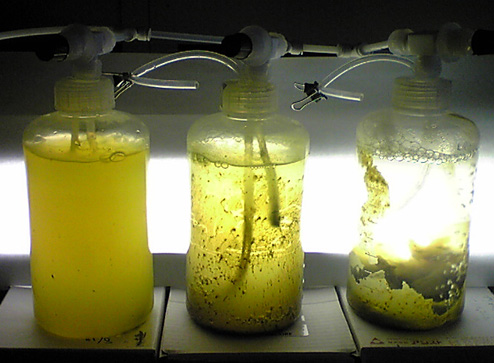|
研究内容:
Novel Approach to Oceanic Algal Ecosystem:
Microorganisms represent the majority of genetic and metabolic diversity on Earth and they drive important ecological and biogeochemical processes. However, most of our knowledge about microorganisms is derived from experimental studies of isolates in the laboratory. Environmental studies have revealed that as much as 99% of all microbial diversity remains uncultured or uncharacterized. Because much of what a microbe ‘does’ is in direct response to other microbes, or to environmental conditions not experienced in a petri dish, much of the true ecological function of microbes can only be explored from a community or ecosystem-level perspective. Thus, one current challenge in microbiology is to apply laboratory-style observations in an experimental framework to known and unknown organisms as they interact with each other.

Fig 1. Three test ecotrons. The first is an artificial construct composed of isolated cyanobacteria and a natural enrichment of water from Iriomote in Okinawa prefecture. The middle is a 6-month old enrichment of seawater collected near the Maritime Museum of Science in Odaiba. This bottle is currently dominated by Cyanobium (a cyanobacterium) and several heterotrophic bacteria, but undergoes periodic changes. The bottle on the right is also six months old and is from Iriomote. This ecotron transitioned to a mat community dominated by Phormidium and an as yet unknown eukaryotic alga. Other eukaryotes including flagellates and crustaceans make this ecotron their home.
My project attempts to do just that, by developing stable microcosms in the laboratory called ‘ecotrons’ using marine phytoplankton communities (see figure 1). Such systems are very difficult to establish, but by observing natural communities as they transition to ecotron conditions, and subsequently experimentally manipulating the system we can find clues to enable promotion of diversity and stability (see figure 2). To this end an integrated multi-omic approach (genome, proteome, transcriptome and metabolome) coupled with traditional microbiological methods (isolations, microscopy, etc.) will allow us to observe exactly how natural communities transition to artificial ones and see what processes account for the winners and losers as the ecotron decays to stability.

Fig 2. A hypothetical dynamically stable ‘community’ of 4 species. The x-axis shows relative abundance and the y-axis is time. In this example, the purple species remains constant, while the three remaining species respond to alternating manipulations to the system (e.g. red and blue arrows which for example, could represent artificial mixing or nutrient amendment), which allows for succession between them.
This is a great challenge, but from the applied perspective, the potential benefits are also great. Because of their metabolic diversity, microorganisms offer great potential for new enzymes, chemicals and biochemical pathways useful to science, industry and medicine. In particular, algal research is important because algae-based systems show great promise for biomass and biochemical production. Exploration and manipulation of community-level processes in a laboratory setting is one promising path towards sustainable bioenergy.
・・・
Banerjee, M., Everroad, R.C. and Castenholz, R.W. 2009. An Unusual Cyanobacterium from Saline Thermal Waters with Relatives from Unexpected Habitats. In press. Extremophiles.
Everroad, R.C. and Wood, A.M. 2006. Comparative Molecular Evolution of Newly Discovered Picocyanobacterial Strains Reveals a Phylogeneticaly Informative Variable Region of β-Phycoerythrin. Journal of Phycology. 42:1300-1311.
Everroad, C., Six, C., Partensky, F., Thomas, J.C., Holztendorff, J., and Wood, A. M. 2006. Biochemical Bases of Type IV Chromatic Adaptation in Marine Synechococcus spp. Journal of Bacteriology. 188:3345-3356.
Wood, A.M., Everroad, R.C. and Wingard, L.M. 2005. Measuring Growth Rates in Microalgal Cultures. p. 269-285. In Anderson, R. [Ed.] Algal Culturing Techniques. Phycological Society of America.
|








